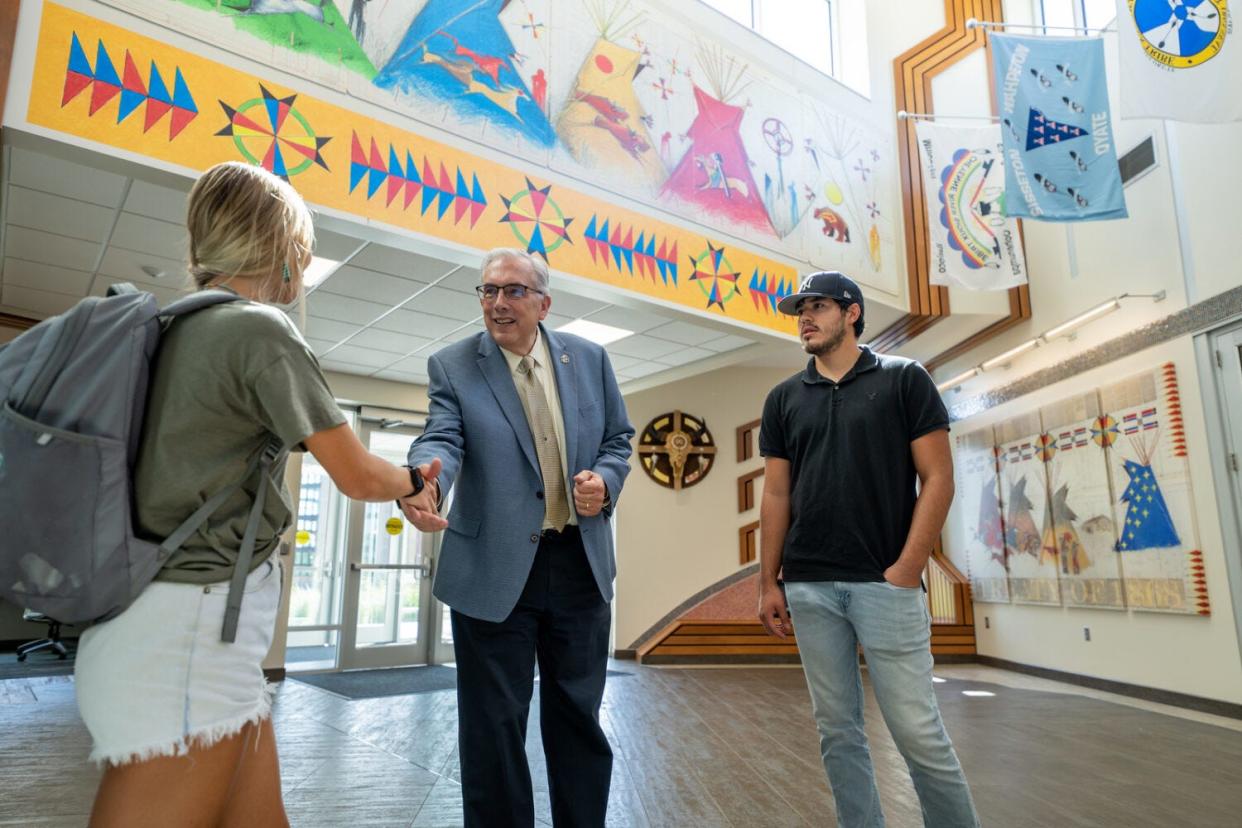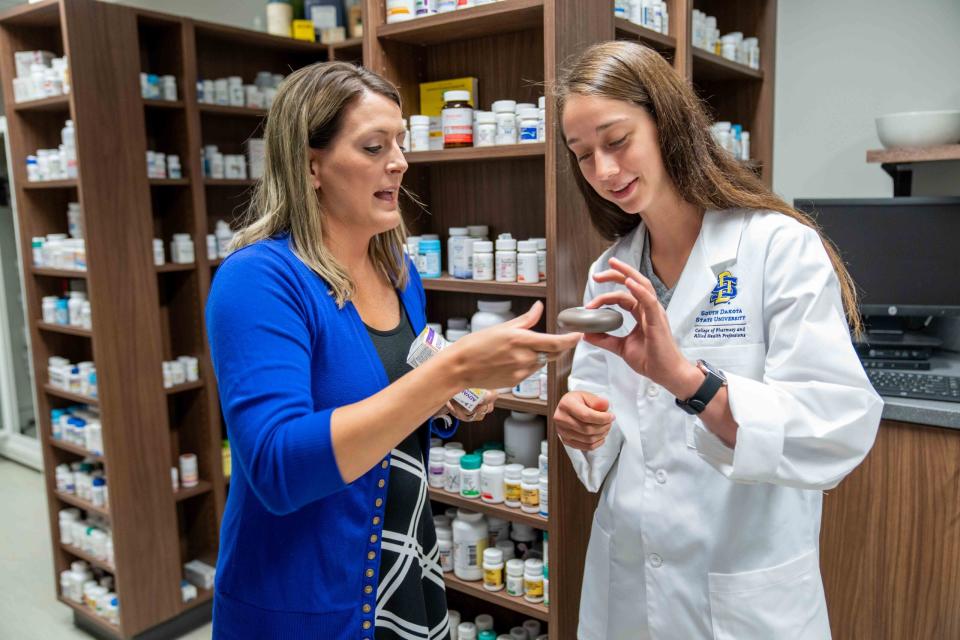‘They saw the potential’: SDSU program boosts Native American success

South Dakota State University was the only college that sent recruiters to the reservation during Traelene Fallis’ junior year at Crow Creek Tribal School.
So, she only applied to SDSU.
“It just felt like they actually wanted me to be here,” Fallis said. “They were doing all these things because they saw the potential in us.”
Fallis was among the first graduating class of SDSU Wokini scholars last spring.
The five-year-old Wokini Initiative is a program intended to create better support systems, higher enrollment and improved graduation rates for Native American students.
So far, the initiative has accomplished just that. As of July 2022, SDSU is the only Board of Regents university to see an increase in Native American enrollment since 2017, and has seen an increase in Native American retention and graduation rates as well.
‘The most glaring societal challenge in our state’
Just short of 9% of South Dakotans are Native American, according to the 2020 U.S. Census.
Yet Native Americans are disproportionately represented in the state’s justice system and higher education. Native Americans made up about 44% of prisoners in South Dakota in fiscal year 2022 and only 2.8% of students enrolled at Board of Regents universities in fall of 2021.
“Probably the most glaring societal challenge in our state has its roots in our history — the long and tortured history between the white settlement that came with colonization and the Indigenous people of our state,” said Barry Dunn, president of South Dakota State.
Dunn is an enrolled member of the Rosebud Sioux Tribe. He saw firsthand the impact of higher education growing up: his mother attended college, while her brothers did not. Their “paths were completely different,” he said.
“When a public university accepts federal resources and says it provides access to all, I take that responsibility seriously. We’re going to figure out a way to get access to all — and that means to the largest minority in our state,” Dunn said. “This is a way to attack our state’s challenge regarding the Indigenous people of our state and the poverty that exists on the reservations and in urban communities in South Dakota.”

Wokini: scholarships, culture & support
One of the biggest barriers to higher education for Native Americans is the cost, Dunn said.
It costs about $18,000 a year for South Dakota students to attend SDSU. In developing its Wokini Initiative, the school hoped to bridge the gap between government aid and non-university scholarships.
Wokini scholars receive $5,000 scholarships each year for up to five years. The school has raised roughly $28 million for the initiative — $5 million to build an American Indian Student Center and $18 million for scholarships, among other initiatives.
“Getting that scholarship was the main reason I was able to go to school,” said Fallis, an enrolled member of the Crow Creek Tribe. “And it’s the reason for a lot of other Indigenous students being able to go.”
Fallis is the first in her immediate family to earn a bachelor’s degree. Her sister tried attending college but “it just didn’t work out.”
Fallis graduated with a bachelor’s degree in animal science last spring and is in her first year of veterinary school.
Aside from her scholarships, Fallis said additional support systems and programs created by the initiative helped her succeed in school, such as the student center, specific advisers for Wokini students and student organizations.
Fallis said her education would have been much harder without the support.
The program also established an Oyate Living Learning Community for first-year students in one of the dorms. Freshman Wokini students live on the same floor so they’re more easily able to connect with one another, said Jessica Begeman, a pre-pharmacy undergraduate student and Wokini scholar.
“You don’t have to explain why you’re smudging your room,” said Begeman, an Oglala Sioux tribal member from Martin. Smudging involves ceremonially burning sacred herbs, such as sage, to purify a space or person.
“You don’t have to feel like you’re explaining things about yourself; they just understand you and where you’re from,” Begeman added. “There’s less stress on you to state who you are or prove who you are.”
SDSU ‘never really tracked’ retention for Native American students
The rate of Native American students graduating within six years was formerly less than 20%, Dunn estimated, adding that the freshman retention rate “must have been terrible.”
“We never really tracked it before,” Dunn said. “It wasn’t a group of students we paid a lot of attention to.”
Dunn suspects the retention rates were so low because proper support systems weren’t in place for students. Native American students easily feel disconnected from their culture and families, in addition to struggling with high costs to attend school and challenges associated with potentially poor educational backgrounds.
“They’ve heard stories of failure from cousins or aunts and uncles,” Dunn said. “We don’t have a history of being a place where people succeeded. And if you came to college and took out student loans and didn’t get a degree, then you’ve really got trouble.”
Twenty-five Wokini students graduated last spring, and the freshman retention rate from 2021 to 2022 was 70%. While it’s not as high as the entire student body, it is “much better than before,” Dunn said.
Dunn was recognized for his work with the Wokini Initiative in 2022, earning the McGraw Prize for Higher Education. In addition to the recognition, he received $50,000 in prize money.
He plans to put that back into scholarships for the Wokini Initiative over time.
“I feel like a grandpa here,” Dunn said. “I’m really, really proud of them.”

Paying back for the land
The former Great Sioux Reservation spanned about 60 million acres, encompassing all of western South Dakota and parts of surrounding states. The reservation was promised to the Lakota people in the Fort Laramie Treaty of 1868.
But two decades later, the federal government broke up tribal lands into smaller reservations and claimed much of the land in West River under the Dawes Act of 1887 — two years before South Dakota became a state and SDSU officially became a land-grant college.
After South Dakota earned statehood, and to fulfill the obligations to be a land grant college, SDSU was endowed with thousands of acres of federally controlled land through the Morrill Act to raise funds for the institution’s academic mission through land sales or rentals. Much of the land granted to SDSU formerly made up the Great Sioux Reservation before it was broken apart.
SDSU still retains much of that public land, receiving between $500,000 and $750,000 a year from land rent and sales, Dunn said.
Historically, those annual funds flowed into the university’s general fund for operational or overhead expenses.
But Dunn specified such funds must go toward supporting Native American students, since that land originally belonged to Native Americans. He said merely acknowledging that South Dakota’s land grant universities benefit from Native American lands is not enough.
SDSU has provided an additional recruiter focusing on South Dakota’s nine tribal nations, an additional academic adviser for Native American students, and increased programming for students with the funds.
Impact on South Dakota, tribal nations
The impact of the Wokini Initiative isn’t instantaneous. It’ll come a generation or two later, Dunn said, when Native American youth will regularly see higher education as a right rather than an impossibility.
Begeman said she saw college as a natural choice because several of her family members attended higher education, including her parents and grandfather.
“For me, it wasn’t really a question of whether or not I could do it. It was a question of whether or not I wanted to,” Begeman said.
Dunn emphasized that while the Wokini program has received some criticism from tribal colleges, SDSU is filling an educational need with a “breadth of degrees” that aren’t available at tribal colleges, such as pharmacy or veterinary degrees.
Oglala Lakota College, Sinte Gleska University and Sisseton Wahpeton Community College did not respond to multiple requests for comment from South Dakota Searchlight.
“We’re not trying to uproot people from the reservation,” Dunn said.
Begeman interned with the Indian Health Service last summer, and she saw the difference she can make in her community as a pharmacist. She hopes to work in South Dakota after finishing her doctorate and residency.
“The students who graduate can go home to their communities and eventually support them with knowledge gained through school — pharmacy, health care, teaching, engineering,” Begeman said. “It’s really just trying to help the community learn and expand.”
The same is true for Fallis. She plans to return to the Crow Creek Reservation, open a vet clinic and help her community with animal care.
“My dreams were never too big and they always believed in me,” Fallis said of her tribe. “Just because of where I came from, other people would ask if I can really do that.”
This article originally appeared on Sioux Falls Argus Leader: ‘They saw the potential’: SDSU program boosts Native American success

